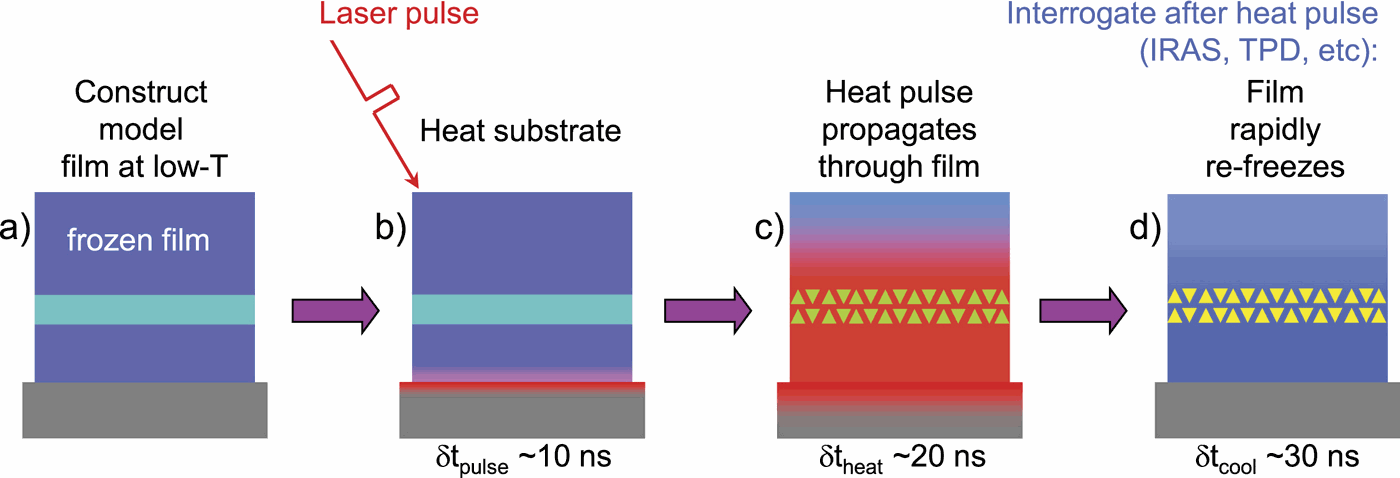当前位置:
X-MOL 学术
›
J. Chem. Phys.
›
论文详情
Our official English website, www.x-mol.net, welcomes your
feedback! (Note: you will need to create a separate account there.)
A nanosecond pulsed laser heating system for studying liquid and supercooled liquid films in ultrahigh vacuum
The Journal of Chemical Physics ( IF 3.1 ) Pub Date : 2016-04-26 15:20:46 , DOI: 10.1063/1.4947304 Yuntao Xu 1 , Collin J. Dibble 1 , Nikolay G. Petrik 1 , R. Scott Smith 1 , Alan G. Joly 1 , Russell G. Tonkyn 1 , Bruce D. Kay 1 , Greg A. Kimmel 1
The Journal of Chemical Physics ( IF 3.1 ) Pub Date : 2016-04-26 15:20:46 , DOI: 10.1063/1.4947304 Yuntao Xu 1 , Collin J. Dibble 1 , Nikolay G. Petrik 1 , R. Scott Smith 1 , Alan G. Joly 1 , Russell G. Tonkyn 1 , Bruce D. Kay 1 , Greg A. Kimmel 1
Affiliation

|
A pulsed laser heating system has been developed that enables investigations of the dynamics and kinetics of nanoscale liquid films and liquid/solid interfaces on the nanosecond time scale in ultrahigh vacuum (UHV). Details of the design, implementation, and characterization of a nanosecond pulsed laser system for transiently heating nanoscale films are described. Nanosecond pulses from a Nd:YAG laser are used to rapidly heat thin films of adsorbed water or other volatile materials on a clean, well-characterized Pt(111) crystal in UHV. Heating rates of ∼1010 K/s for temperature increases of ∼100–200 K are obtained. Subsequent rapid cooling (∼5 × 109 K/s) quenches the film, permitting in-situ, post-heating analysis using a variety of surface science techniques. Lateral variations in the laser pulse energy are ∼±2.7% leading to a temperature uncertainty of ∼±4.4 K for a temperature jump of 200 K. Initial experiments with the apparatus demonstrate that crystalline icefilms initially held at 90 K can be rapidly transformed into liquidwaterfilms with T > 273 K. No discernable recrystallization occurs during the rapid cooling back to cryogenic temperatures. In contrast, amorphous solid waterfilms heated below the melting point rapidly crystallize. The nanosecond pulsed laser heating system can prepare nanoscale liquid and supercooled liquid films that persist for nanoseconds per heat pulse in an UHV environment, enabling experimental studies of a wide range of phenomena in liquids and at liquid/solid interfaces.
中文翻译:

纳秒脉冲激光加热系统,用于研究超高真空下的液膜和过冷液膜
已经开发了脉冲激光加热系统,该系统能够在超高真空(UHV)的纳秒级时间尺度上研究纳米级液膜和液/固界面的动力学和动力学。描述了用于瞬时加热纳米级薄膜的纳秒脉冲激光系统的设计,实现和表征的详细信息。来自Nd:YAG激光器的纳秒脉冲用于在特高压中干净,特征明确的Pt(111)晶体上快速加热吸附的水或其他挥发性物质的薄膜。获得的加热速率约为10 10 K / s,温度升高约为100-200K。随后的快速冷却(〜5×10 9 K / s)使薄膜淬火,从而可以原位进行,使用多种表面科学技术进行后加热分析。激光脉冲能量的横向变化为〜±2.7%,导致200 K的温度跃变时的温度不确定性为〜±4.4K。该设备的初始实验表明,最初保持在90 K的结晶冰膜可以迅速转变为液态水膜。 T> 273K。在快速冷却回低温时没有明显的重结晶发生。相反,加热到熔点以下的无定形固体水膜迅速结晶。纳秒脉冲激光加热系统可以制备在超高压环境中每个热脉冲持续几纳秒的纳米级液体和过冷液膜,从而可以对液体中以及液/固界面处的多种现象进行实验研究。
更新日期:2016-04-27
中文翻译:

纳秒脉冲激光加热系统,用于研究超高真空下的液膜和过冷液膜
已经开发了脉冲激光加热系统,该系统能够在超高真空(UHV)的纳秒级时间尺度上研究纳米级液膜和液/固界面的动力学和动力学。描述了用于瞬时加热纳米级薄膜的纳秒脉冲激光系统的设计,实现和表征的详细信息。来自Nd:YAG激光器的纳秒脉冲用于在特高压中干净,特征明确的Pt(111)晶体上快速加热吸附的水或其他挥发性物质的薄膜。获得的加热速率约为10 10 K / s,温度升高约为100-200K。随后的快速冷却(〜5×10 9 K / s)使薄膜淬火,从而可以原位进行,使用多种表面科学技术进行后加热分析。激光脉冲能量的横向变化为〜±2.7%,导致200 K的温度跃变时的温度不确定性为〜±4.4K。该设备的初始实验表明,最初保持在90 K的结晶冰膜可以迅速转变为液态水膜。 T> 273K。在快速冷却回低温时没有明显的重结晶发生。相反,加热到熔点以下的无定形固体水膜迅速结晶。纳秒脉冲激光加热系统可以制备在超高压环境中每个热脉冲持续几纳秒的纳米级液体和过冷液膜,从而可以对液体中以及液/固界面处的多种现象进行实验研究。





















































 京公网安备 11010802027423号
京公网安备 11010802027423号